

Épopée de Gilgamesh. Un article de Wikipédia, l'encyclopédie libre.
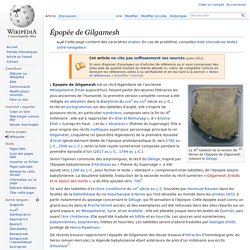
La XIe tablette de la version de Ninive de l’Épopée de Gilgamesh, relatant le Déluge. Selon l’opinion commune des assyriologues, le récit du Déluge, inspiré par l’Épopée babylonienne d’Atrahasis ou « Poème du Supersage », a été ajouté vers 1200 av. J. -C., pour former le texte « standard », comprenant onze tablettes, de l’épopée assyro-babylonienne. La douzième tablette, traduction de la seconde moitié du récit sumérien « Gilgamesh, Enkidu et le séjour des morts », a dû être ajoutée vers -700[1]. De récents travaux rapprochent l’épopée de Gilgamesh des douze travaux d’Héraclès (l’homologue grec du héros romain Hercule), la légende babylonienne étant antérieure de près d'un millénaire aux écrits d’Homère[2].
Résumé[modifier | modifier le code] Gilgamesh, roi de la ville d'Uruk, est dur et intransigeant envers ses sujets. Le récit (version ninivite)[modifier | modifier le code] File:Map greek sanctuaries-en.svg. Cancel Edit Delete Preview revert Text of the note (may include Wiki markup) Could not save your note (edit conflict or other problem).
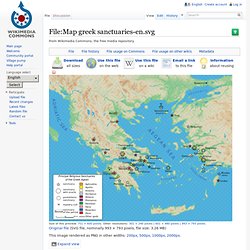
Please copy the text in the edit box below and insert it manually by editing this page. Upon submitting the note will be published multi-licensed under the terms of the CC-BY-SA-3.0 license and of the GFDL, versions 1.2, 1.3, or any later version. See our terms of use for more details. Add a note Draw a rectangle onto the image above (press the left mouse button, then drag and release). Save To modify annotations, your browser needs to have the XMLHttpRequest object. [[MediaWiki talk:Gadget-ImageAnnotator.js|Adding image note]]$1 [[MediaWiki talk:Gadget-ImageAnnotator.js|Changing image note]]$1 [[MediaWiki talk:Gadget-ImageAnnotator.js|Removing image note]]$1. Baalbek Temple and Human Sacrifice worship to Baal - child sacrifices.
Human Sacrifice including child Sacrifice as worship to the God Baal at the Baalbek Temple When we turn to mythology to help understand these calamities we find some puzzling insights.
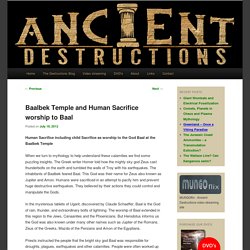
The Greek writer Homer told how the mighty sky god Zeus cast thunderbolts on the earth and tumbled the walls of Troy with his earthquakes. The inhabitants of Baalbek feared Baal. This God was their name for Zeus also known as Jupiter and Amon. Humans were sacrificed in an attempt to pacify him and prevent huge destructive earthquakes. In the mysterious tablets of Ugarit, discovered by Claude Schaeffer, Baal is the God of rain, thunder, and extraordinary bolts of lightning. Priests instructed the people that the bright sky god Baal was responsible for droughts, plagues, earthquakes and other calamities. Hypogeum of Ħal-Saflieni. The Hypogeum of Paola, Malta, (Ipoġew in Maltese) literally meaning "underground" in Greek, is a subterranean structure dating to the Saflieni phase (3000-2500 BC) in Maltese prehistory.
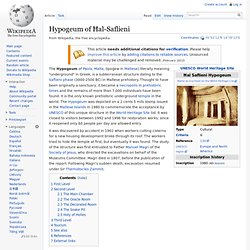
Thought to have been originally a sanctuary, it became a necropolis in prehistoric times and the remains of more than 7,000 individuals have been found. It is the only known prehistoric underground temple in the world. The Hypogeum was depicted on a 2 cents 5 mils stamp issued in the Maltese Islands in 1980 to commemorate the acceptance by UNESCO of this unique structure in the World Heritage Site list. It was closed to visitors between 1992 and 1996 for restoration works; since it reopened only 60 people per day are allowed entry.
It was discovered by accident in 1902 when workers cutting cisterns for a new housing development broke through its roof. First Level[edit] The first level is very similar to tombs found in Xemxija in Malta. Second Level[edit] Hal Saflieni. Mohenjo-daro. Location of Mohenjo-daro within the Pakistani province of Sindh.
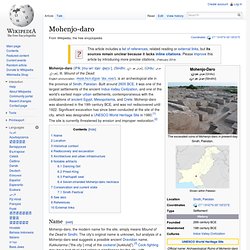
Mohenjo-daro (IPA: [muˑənⁱ dʑoˑ d̪əɽoˑ], (Sindhi: موئن جو دڙو), (Urdu: موئن جودڑو), lit. Mound of the Dead; English pronunciation: /moʊˌhɛn.dʒoʊ ˈdɑː.roʊ/), is an archeological site in the province of Sindh, Pakistan. Built around 2600 BCE, it was one of the largest settlements of the ancient Indus Valley Civilization, and one of the world's earliest major urban settlements, contemporaneous with the civilizations of ancient Egypt, Mesopotamia, and Crete.
Mohenjo-daro was abandoned in the 19th century BCE, and was not rediscovered until 1922. Family tree of the Greek gods. Key: The essential Olympians' names are given in bold font.
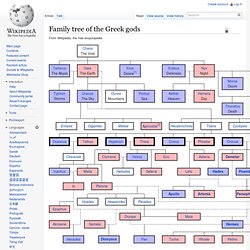
See also List of Greek mythological figures Notes External links Media related to Family trees of Greek mythology at Wikimedia Commons. The Monumental Baalbek – The largest building blocks on Earth. In Lebanon, at an altitude of approximately 1,170 meters in Beqaa valley stands the famous Baalbek or known in Roman times as Heliopolis.
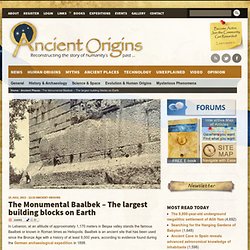
Baalbek is an ancient site that has been used since the Bronze Age with a history of at least 9,000 years, according to evidence found during the German archaeological expedition in 1898. Exhibition - The Saga of the Thracian Kings - Archaeological Discoveries in Bulgaria.